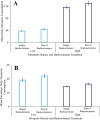The life history and mosquito consumption dynamics of Notonecta indica (Hemiptera: Notonectidae) in eastern Jamaica
- PMID: 39936611
- PMCID: PMC11815496
- DOI: 10.1093/jisesa/ieaf013
The life history and mosquito consumption dynamics of Notonecta indica (Hemiptera: Notonectidae) in eastern Jamaica
Abstract
Certain mosquito species pose a significant threat to human health, causing thousands of deaths annually via diseases such as yellow fever, dengue fever, and chikungunya. A variety of insects, including dragonflies and backswimmers, prey on mosquito larvae, providing natural population suppression, but knowledge of the life history and quantification of the mosquito suppression dynamics of these insects remain limited in the Caribbean. In the present study, we documented aspects of the life history of the backswimmer Notonecta indica L. in Jamaica and quantified its consumption of Aedes aegypti (L.) larvae throughout development and at different mosquito densities. The egg and fifth nymphal stages had the longest mean development times while the third nymphal stage had the shortest. Development was noted to be shorter in N. indica when compared to other backswimmer species from different climates, likely due to higher temperatures and greater food availability in the present study. Daily mosquito consumption increased exponentially throughout nymphal development. Individual adults displayed significant variation in daily mosquito consumption, and consumption was found to be directly proportional to mosquito density. Backswimmers may contribute to mosquito suppression and the reduction of mosquito-borne diseases, but their contribution is likely limited by the spatial and temporal differences between backswimmers and mosquitoes, namely, in habitat preferences, dispersal patterns, and development times.
Keywords: backswimmer; density; development; oviposition; predator.
© The Author(s) 2025. Published by Oxford University Press on behalf of Entomological Society of America.
Figures









Similar articles
-
Sublethal exposure to pyriproxyfen does not impair the abilities of the backswimmer Buenoa amnigenus to prey upon Aedes aegypti larvae.Ecotoxicology. 2022 Aug;31(6):998-1008. doi: 10.1007/s10646-022-02562-2. Epub 2022 Jul 2. Ecotoxicology. 2022. PMID: 35779162
-
Aedes (Stegomyia) aegypti in the continental United States: a vector at the cool margin of its geographic range.J Med Entomol. 2013 May;50(3):467-78. doi: 10.1603/me12245. J Med Entomol. 2013. PMID: 23802440
-
Eutrophication governs predator-prey interactions and temperature effects in Aedes aegypti populations.Parasit Vectors. 2019 Apr 24;12(1):179. doi: 10.1186/s13071-019-3431-x. Parasit Vectors. 2019. PMID: 31014388 Free PMC article.
-
A meta-analysis reveals that dragonflies and damselflies can provide effective biological control of mosquitoes.J Anim Ecol. 2023 Aug;92(8):1589-1600. doi: 10.1111/1365-2656.13965. Epub 2023 Jun 4. J Anim Ecol. 2023. PMID: 37272224 Review.
-
Dengue-mediated changes in the vectorial capacity of Aedes aegypti (Diptera: Culicidae): manipulation of transmission or infection by-product?J Med Entomol. 2025 Jan 13;62(1):19-28. doi: 10.1093/jme/tjae134. J Med Entomol. 2025. PMID: 39436782 Free PMC article. Review.
References
-
- Ajibade OO, Tota-Maharaj K, Clarke B.. 2016. Challenges of poor surface water drainage and wastewater management in refugee camps. Environ. Earth Sci. Res. J. 3:53–60. https://doi.org/10.18280/eesrj.030402 - DOI
-
- Ali I, Mundle M, Anzinger JJ, et al.2019. Tiger in the sun: a report of Aedes albopictus in Jamaica. Acta Trop. 199:105112. https://doi.org/10.1016/j.actatropica.2019.105112 - DOI - PubMed
-
- Anderson MT, Kiesecker JM, Chivers DP, et al.2001. The direct and indirect effects of temperature on a predator–prey relationship. Can. J. Zool. 79:1834–1841. https://doi.org/10.1139/cjz-79-10-1834 - DOI
-
- Ayala-Sulca Y, Cóndor-Alarcón R, Colos-Galindo P, et al.2022. Predatory effect and selectivity of prey of Notonecta peruviana (Hemiptera: Notonectidae) on the larval control of mosquitoes (Diptera: Culicidae). Oecol. Aust. 26:34–44. https://doi.org/10.4257/oeco.2022.2601.04 - DOI
-
- Bare CO. 1926. Life histories of some Kansas ‘backswimmers’. Ann. Entomol. Soc. Am. 19:93–101. https://doi.org/10.1093/aesa/19.1.93 - DOI
MeSH terms
Grants and funding
LinkOut - more resources
Full Text Sources

